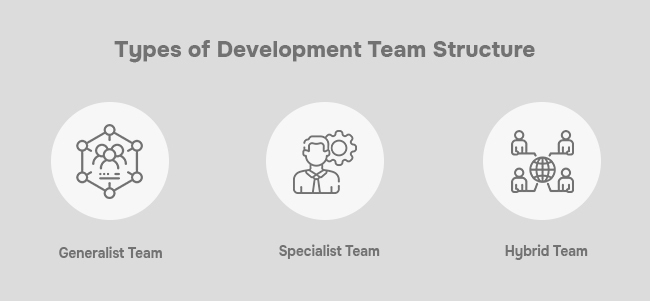
A dedicated development team's structure plays a significant role in a project's success. Although, other factors like developers' expertise, experience, and talent are also critical. Yet, proper management and team make the development process easier, faster, and more profitable. So, if you're on the path of hiring a dedicated software development team – we welcome you to indulge in these insights from our experts. In this article, we'll cover such issues as approaches to organizing a development team's workflow, agile and traditional team differences, and give tips on structuring your dedicated development team.
Software Development Team Structure Approaches
The first thing, while structuring a dedicated team, you need to decide the type of development team for your project and know what business goals you want to achieve precisely. There are 3 main approaches to arranging a development team. Let's call them generalist, specialist, and hybrid. So, in this section, we'll look at their strong and weak sides and give some examples of when one might be more suitable for you than the other.

1. Generalist Approach
A generalist structure refers to an organizational or team structure where individuals have a broad range of skills and expertise rather than being specialized in one specific area. In a generalist structure, team members may be required to perform various tasks and may be responsible for multiple aspects of a project or product.
Pros
In a generalist structure, team members usually have multi-disciplinary skills and knowledge that allow them to take on different roles and responsibilities as needed. This structure can benefit small teams or projects with limited resources and expertise. It also allows for greater flexibility and adaptability to changing project needs and priorities.
Cons
However, it's important to note that a generalist structure can also have some downsides; for example, team members may not have the same level of expertise as a specialist in a specific area, so the outcome might not be the same quality as expected. Additionally, generalists may be spread too thin and not able to focus on a single task entirely.
2. Specialist Approach
A specialist structure refers to an organizational or team structure where individuals have a high level of expertise in one specific area or function. In a specialist structure, team members are highly skilled and focused on a specific aspect of a project or product, such as software development, QA testing, or project management.
Pros
The advantage of a specialist structure is that team members have a deep understanding of their field of expertise and can bring a high level of skill and knowledge to their specific role. This can result in a higher quality of work and more efficient problem-solving. Additionally, this structure usually allows for better scalability, as a project or team can grow by adding more specialists in different areas.
Cons
However, a specialist structure can have some downsides. Team members may not be able to adapt to change easily or take on multiple roles, which could make it difficult to respond to unexpected or changing project needs. It could also make the team less agile and less capable of handling diverse needs and problems.
3. Hybrid Approach
A hybrid approach is a combination of both a generalist and specialist structure. In this approach, an organization or team has a mix of team members with a broad range of skills and expertise (generalists) as well as team members with a high level of expertise in one specific area or function (specialists). This approach can be particularly useful for larger organizations or projects where there is a need for specialized expertise in specific areas, as well as the flexibility to adapt to changing project needs.
Pros
The hybrid approach allows for greater flexibility and adaptability to changing project needs while leveraging specialists' deep expertise and skills. Generalists can take on multiple roles and responsibilities, fill in gaps and help the team to be more agile. Specialists can focus on their specific areas of expertise and deliver high-quality work.
Cons
The downside of hybrid approach is that it can be more expensive, as it may require a larger team size with a mix of specialists and generalists. Coordination between generalists and specialists may be more difficult as they may have different work methods and communication styles. Generalists may not have the same level of expertise as specialists in their specific area, which could lead to inefficiency and lower quality of work in certain areas.
Agile Development Teams Vs. Traditional Development Teams
When companies create teams for projects, they can be agile or follow traditional corporate values. Agile software development and traditional software development teams are two different approaches to developing software. Agile software development is a method that emphasizes iterative, incremental, and flexible processes. Teams work in short sprints, typically for 2-4 weeks. They focus on delivering small, working chunks of the software (referred to as "features") to the client or end-user as soon as they are ready. These teams prioritize customer satisfaction, flexibility, and rapid delivery. On the other hand, traditional software development teams often use a more structured, linear approach to software development, often referred to as the Waterfall model. The Waterfall model is a linear sequential approach, which involves distinct phases of requirements gathering, design, development, testing, and maintenance. It is generally less flexible than Agile and more focused on strict planning and documentation. Both approaches have their advantages and disadvantages. Agile software development allows for more flexibility and adaptability to changing project requirements, but it can be challenging to plan for long-term goals. On the other hand, traditional software development teams allow for more detailed planning and documentation, but they can be less adaptable to changes in project requirements. It's important to note that Agile and Waterfall are not mutually exclusive methodologies; teams can incorporate some of Agile's principles and practices in a Waterfall environment and make it more flexible.

Tips for Structuring your Dedicated Software development Teams
Now that you know about Team structure approaches and different methodologies, here are some tips for successfully structuring your dedicated software development team.
Assess the project requirements
Before you begin assembling a team, it's important to clearly understand the project requirements and the skills and expertise required to complete the project successfully. This will help you identify the roles and responsibilities that need to be filled and the qualifications and experience each team member should possess.
Assemble the right team:
Once you clearly understand the project requirements, you can assemble a team of software developers, project managers, QA engineers, and designers. It's important to select team members with the appropriate skills and experience to meet the project's needs and who can work well together as a team.
Clearly define roles and responsibilities
By clearly defining the roles and responsibilities of each team member, you can ensure that everyone is aware of their specific tasks and can work together effectively. This will also help avoid confusion or overlap in responsibilities, making it easier for everyone to understand the structure and function of your team.
Promote effective communication
Strong communication is essential for a dedicated software development team to function effectively. Encourage team members to share their ideas, concerns, and feedback, and create a culture of transparency and open communication. Regular team meetings and a communication platform can ensure the team members are well informed about the project status, risks, and issues, if any.
Provide ongoing support and training
A dedicated software development team should be provided with ongoing support and training to help them stay up-to-date with the latest technologies and best practices. This will not only help them deliver high-quality software but also help them improve their skills and retain them in the company.
Ending Note
Simply having an idea of a software product is not enough. You need to hire the right people to implement your project smoothly and successfully. We hope our blog on the dedicated software development team structure will help you improve your knowledge of software development. But if you still have questions, we are here to help! Whizzbridge has been assembling dedicated teams for many years, and we are ready to start building your agile team that will lead your project to success.

Get In Touch
We're a team of passionate experts dedicated to driving growth for businesses of all sizes. Schedule a consultation now!





